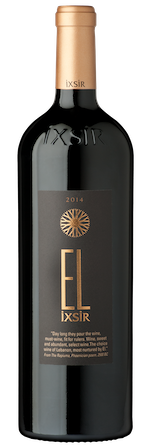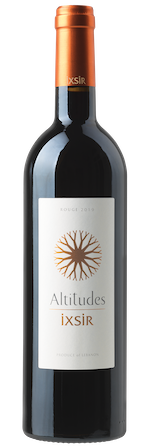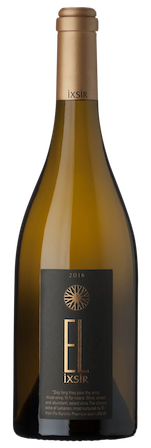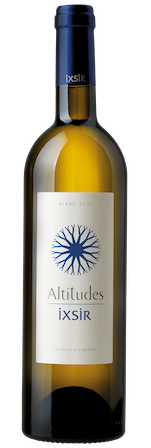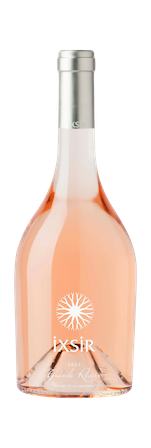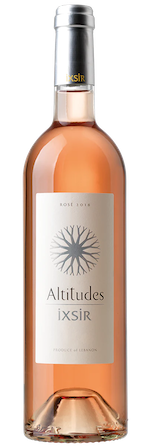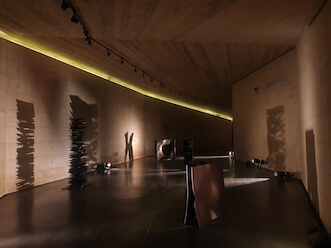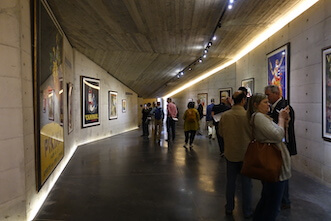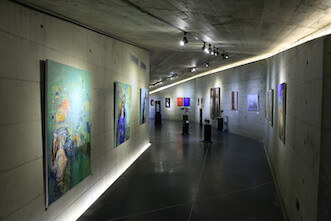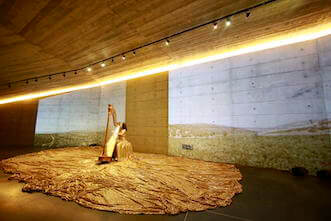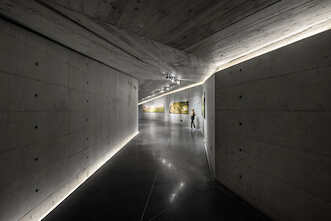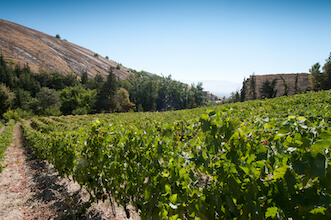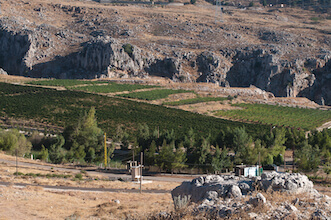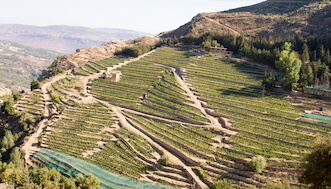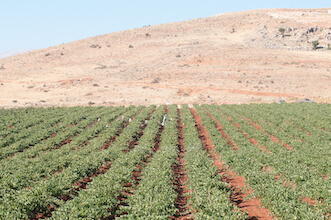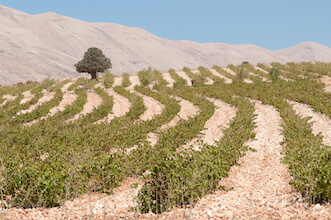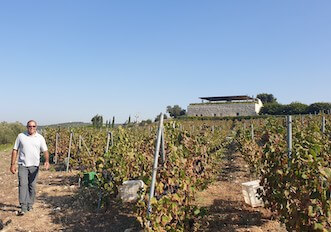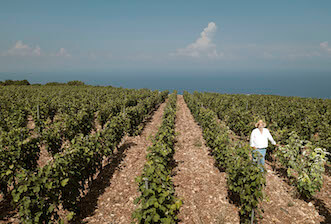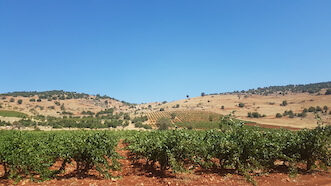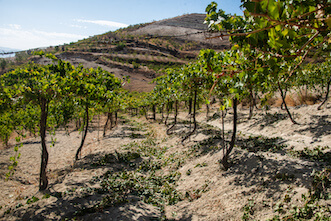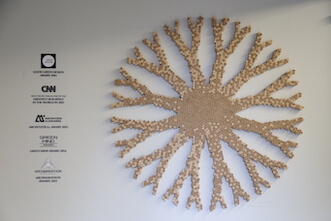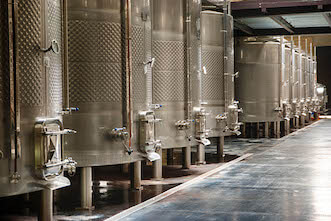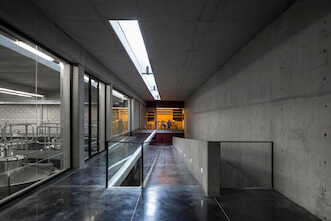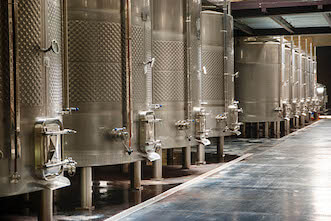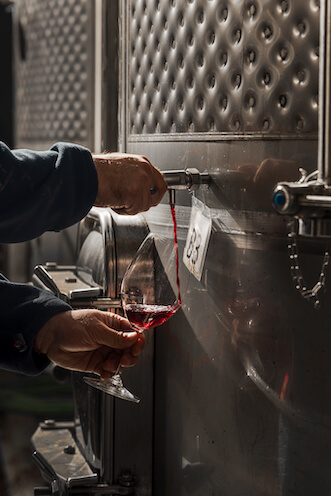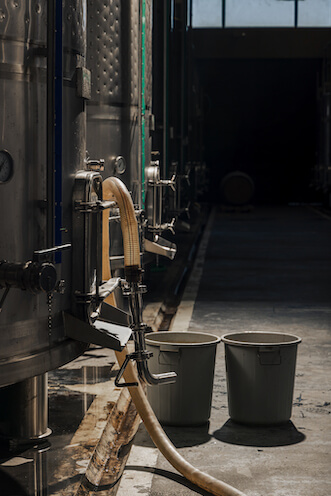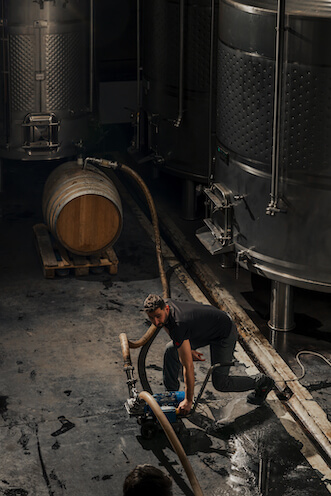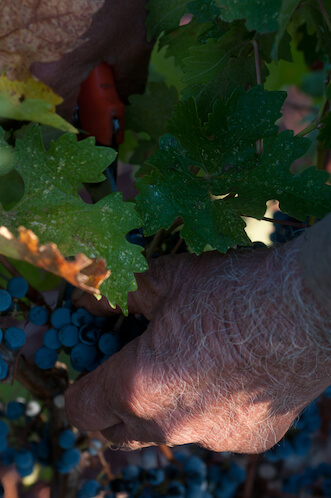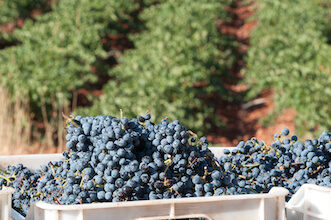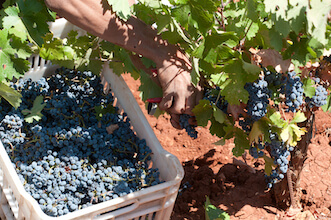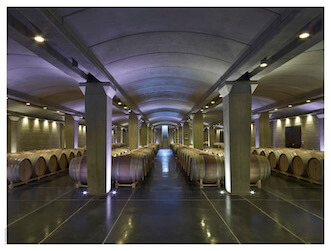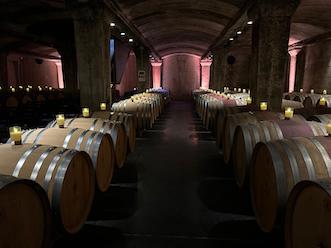START THE TOUR
Welcome to IXSIR's winery. Get ready for an unforgettable journey that immerses you in the world of fine winemaking
Fill up the form to start the tour
Start the tour
Press the play button for a comprehensive overview of each station as you explore the winery
1-The Winery
The House - The Logo - The Meaning of Ixsir
01:192-The Tunnel
01:333-Our Terroirs
06:054-After the Door
01:265-Fermentation Tanks
01:196-Our Wines
03:267-The Bottling Room
01:188-The Cellar
01:15The Winery
The House - The Logo - The Meaning of Ixsir


Step back in time as you enter our winery housed in a 380-year-old building previously owned by the AL-Bitar Family who ruled the area from the coast of Batroun all the way to Douma. Carefully restored to its original glory and heritage—using old traditional techniques—this historic house now sets the stage for our winemaking journey. As you take the stairs, feel invited to explore the depths where our winery unfolds its magic.
The Logo:
The IXSIR logo represents the vine roots, sprawling in all directions within the soil. This emblem reflects our diverse terroirs scattered around the mountains of Lebanon. The logo also incorporates the sun, highlighting Lebanon’s status as a sunny country with nearly 300 days of sunshine annually. Both the soil and the sun are key factors that solidify Lebanon’s position as a premier wine-making country.
The Meaning of IXSIR:
The name IXSIR comes from ‘Iksir,’ the original Arabic word for ‘Elixir,’ which signifies the purest essence of all substances. Widely recognized in many languages, it is also celebrated as a secret potion that grants eternal youth and love.
The Tunnel


The tunnel serves as a vital link between the old and the new. Established since 2009, IXSIR is committed to have a winery that is modern, while placing traditions at the core of its philosophy.
This space here in the tunnel is also often used to showcase works by emerging Lebanese artists.
Unlike all other Middle Eastern countries, Lebanon is the only country that doesn’t have a desert, giving it a very particular climate. Even though it’s a small country, the country features a remarkable diversity of micro-climates across its beautiful mountains. This allows us to grow a variety of grapes, each in their ideal conditions.
IXSIR cultivates its grapes in not one, but six Lebanese mountains, showing to the world what can be done in this small country. The diverse terroirs stretch from north to south, including Batroun, Jezzine, Niha, Halwa, Bechwat and Ainata.
Our terroir in Ainata is the highest terroir in Lebanon and one of the highest in the northern hemisphere, at 1,800m above sea level.
Please take a moment to watch the short film being projected in the tunnel.
After exiting the tunnel, please take a moment to view the pictures displayed on the wall.
If you’re interested in knowing more about each of our unique terroirs while viewing the pictures, press “Continue”. If not, skip to Station 4.
Our Terroirs


Batroun/ Basbina
IXSIR’s vineyards in Basbina, an abandoned village perched right above Batroun, are the ones closest to the Mediterranean coastline. At 400 meters above sea level, the Syrah, Mourvèdre and Petit Verdot grape varietals grown here enjoy a slightly more temperate climate, while benefiting from constant and cooling sea breezes. Basbina is home to IXSIR’s domaine, a 17th-century historic Lebanese home that was renovated in keeping with its noble architectural heritage, and then transformed into a state-of-the-art wine manufacturing facility by Lebanese architect Raëd Abillama. The choice to set IXSIR’s 20-hectare vineyard and its domaine in Basbina, in the Batroun area, is a carefully considered decision: the town’s winemaking traditions date back to antiquity. In fact, Batroun was once named Botrus, the Greek word for grape, acknowledging the Mediterranean city’s former role as the grape and wine export hub of the Byzantine Empire, spreading wine culture around the world.
Ainata
Soaring 1,800 meters above sea level, the small mountain village of Ainata is the highest inhabited town in all of Lebanon. About a 50-minute drive from Bsharre and set on Mount Lebanon’s eastern slopes, high above the Bekaa Valley, Ainata benefits from a unique climate: very snowy winters and temperate summers. Even in summer, nighttime temperatures remain consistently cool, offering prime condition for a smooth and slow maturation of the berries. The climate, combined with Ainata’s clay and limestone soil, allows the grapes to preserve flavor and freshness at their best, with a great potential for aging. Ainata is home to green juniper forests – the juniper is an evergreen coniferous tree that’s one of Lebanon’s most important forest species, along with the famous cedar. IXSIR’s nine-hectare vineyard here is among the highest in the northern hemisphere, and it produces Syrah, Cabernet Sauvignon and Caladoc grapes.
Bechouat
Deir El Ahmar, which means “red monastery”, is one of the oldest winemaking regions in the world. Dating to the Roman era and possibly even further back, grape cultivation and wine production have long been part of the area’s traditions. Roman Emperor Caracalla built a temple to Jupiter nearby, and Christian monks later used Deir El Ahmar’s distinctive red clay to build a monastery atop the temple’s ruins – hence the region’s name. Bechouat, part of Deir El Ahmar and soaring to 1,000 meters, is a Christian pilgrimage site, where divine miracles have purportedly taken place. IXSIR’s 16 hectares of vineyards grow from Bechouat’s rich red soil, which is composed mainly of ferralitic gravelly clay lime, producing such grape varietals as Arinarnoa, Cabernet Sauvignon, Syrah and Tempranillo.
Niha Heights
On their way to Baalbeck and after passing Zahlé, visitors to the Bekaa Valley often swerve off the main road to explore the magnificent Roman ruins at Niha. There are four Roman temples here, two of which stand at 1,200 meters of altitude, close to IXSIR’s three hectares of vineyards. While IXSIR’s vines are a decade old, grape cultivation in Niha predates the Roman era, the rich calcareous soil having drawn grape growers and wine producers to the region for millennia. The wet winters and dry, arid summers provide ideal conditions for the Viognier grape varietal grown in Niha, where the soaring heights of Mount Sannine provide a picturesque backdrop to the area.
Halwa
The Western Bekaa area is one of Lebanon’s loveliest, a multicolored patchwork of agricultural land that becomes all the more breathtaking as you scale Mount Lebanon’s heights. Among this agricultural wealth and at 1,400 meters above sea level lies the town of Halwa, on Mount Lebanon’s eastern side. Halwa’s generous clay and limestone soil, its winters laden with powdery white snow and its blissfully cool summer nights combine to produce a wide diversity of grapes, including Cabernet Sauvignon, Syrah, Carignan, Cinsault, Chardonnay, Sauvignon and Muscat. IXSIR’s vineyards in Halwa spread over 20 hectares of land.
Jezzine
Rising east of Sidon in Southern Lebanon at 950 meters of altitude, Jezzine is a 250-year-old producer of handcrafted knives, made with inlaid mosaics and carved bones, a tradition first started by the Haddad family in 1770. The spectacularly lovely town, surrounded by the largest pine forest in Lebanon, is also home to one of the highest waterfalls. Within this pleasant setting, IXSIR has planted seven hectares of joined vineyards to make the most out of the region’s hills, following ancestral traditions. Growing vineyards on steep terraces was actually traced all the way back to the Roman era. Jezzine’s calcareous clay and limestone rock crack soil produces a remarkable Syrah varietal, with a distinct aroma and flavor, and a concentrated Touriga Nacional grape that results in a naturally sweet wine. In the coming years, IXSIR’s vineyards in Jezzine are expected to grow and eventually cover 20 hectares of land.
After the Door


As you can see, we are now one floor underground.
The winery is completely built underground, into the mountain, offering multiple benefits:
- This design respects the surroundings, the village, and the heritage of the region, with many wondering where our wine is made.
- Here, the earth maintains a stable temperature during all seasons. You will notice that it will get cooler and cooler as we move towards the cellar.
- We use gravity to transport wine from one stage to the next. The grapes free fall to the fermentation tanks from the harvest area located on this floor. When they are fermented and transformed into wine, they carry their journey to the barrel room also using gravity.
- Skylights provide natural daylight throughout the day throughout all floors, minimizing electricity use.
- All organic waste is composted to be used as fertilizer, and rainwater is collected for watering the surrounding greenery.
All of these practices are in place not only to honor the environment, but primarily to respect the grapes themselves, ensuring they receive the finest care, allowing us to showcase the exceptional qualities of our terroirs at their very best.
These efforts have earned us the Good Green Design award and a spot on CNN’s list of the 12 greenest buildings in the world along with other green awards.
Fermentation Tanks


Here, we will explore the journey of the grape from harvest to the moment you enjoy its flavors and aromas.
Grapes harvested from different terroirs, are placed in 18kg crates brought to the winery before being hand-selected, and transferred to fermentation tanks. There, the yeast, found naturally in the grape, transforms the juice’s sugar into alcohol – turning the grape juice into wine. This transformation can take up to 40 days.
The wine then moves through various stages by gravity, from the tanks to the cellar, through pipes hidden in the pillars.
At IXSIR, we follow a practice called “fermentation per plot.” This means that each grape varietal harvested from a specific vineyard is kept separate throughout the winemaking process, from harvest all the way through fermentation and aging.
This meticulous approach allows each grape variety to fully express the unique characteristics of its terroir. Only in the final step are the individual components blended together to create our final IXSIR wines. This method ensures that every bottle captures the essence of the land where the grapes were grown.
If you would like to learn more about how we produce our wines, press “Continue”. If not, skip to Station 7.
Our Wines


Red Wine:
Red wine is made from red grapes.
After hand-picking the red grapes, they are placed in the fermentation tank, where the yeast in the grape will transform the juice into alcohol.
The color, aroma, and tannins of the wine, which are antioxidants crucial for the wine’s ability to age—come from the grape skins and seeds. The process is very similar to steeping a tea bag into hot water; the longer the skins are macerated with the juice, the deeper the color and the richer the concentrations of aromas and tannins. This is why the juice is frequently mixed with the grape skins and seeds during fermentation, a technique we call “remontage.”
Once the fermentation is done, some of the wine extracted will be bottled immediately to be consumed young, and another part will go down to the wooden barrels area to be aged.
Not all wines are meant to be aged in barrels. To successfully age in wood, the grape aromas must be strong enough to complement the wood without being overwhelmed by it. If the grapes lack sufficient intensity, the wood can dominate, resulting in a wine that tastes overly oaky and unbalanced.
White Wine:
To make white wine, we don’t need the skins and seeds like we do for red wines.
After handpicking, we press the white grapes to extract clear juice, which is then transferred to fermentation tanks.
Yeast that were in the skin, are now in the juice, and so begins the fermentation, turning the juice into wine. Depending on the type of wine we want to produce, the wine is either bottled fresh or aged in barrels.
Did you know that we can make white wine from red grapes too? When red grapes are pressed, the juice is clear. This juice ferments just like white grape juice, allowing us to produce white wine from red grapes.
Before Lebanon had an ample supply of white grapes, winemakers sometimes used this technique. Today, all white wines in Lebanon are made from white grapes. However, the practice of using red grapes to produce white wine still occurs around the world. For instance, in the Champagne region of France, Pinot Noir, which is a red grape, is used to make Champagne, a white sparkling wine.
Rosé:
As for Rosé, there are two main methods for making this type of wine.
The first method is known as ‘BLEEDING ROSÉ.’
As we said, the longer the red grape skin is in contact with the wine juice, the more color the wine will have. In this technique, the wine spends a short time in contact with the red grape skins, gaining a pink color. Once the desired shade is reached, we ‘bleed’ off the pink wine into another tank to ferment separately before bottling.
The second method, which we use here at IXSIR and is popular in the French Provence, is called “PRESS ROSÉ”. For this technique, red grapes selected specifically for rosé are pressed very gently and at low temperatures. The pressing helps extract a lightly colored juice, enriched with subtle aromas from the skins and minimal tannins for structure. This juice is then transferred to a fermentation tank, in which it remains until it transforms into the delightful rosé wine we bottle.
The Bottling Room


Whether the wine comes from the fermentation tanks (for young wines – such as our Altitudes Range) – or from Oak Barrels (for already aged wines – such as our Grande Reserve), this is where they get filled in their respective bottles.
The empty bottles are placed at the beginning of the production line, the machine washes them with sterilized water and vacuums the oxygen (in order to make sure that it is perfectly clean and safe to use). When the wine is filled, the bottles are recollected here, at the end of the line.
Not all IXSIR wines are labeled immediately. Some are destined for aging in our barrels in the cellars, and others are labeled as soon as they are ready to be tasted. These typically include white and rosé wines, crafted to be savored young and bursting with fresh flavors.
Unlike most of our whites, the EL White goes through a unique aging process, resulting in a complex and nuanced character.
When we feel like the “un-labeled” bottles are ready, we get them back on the machine, where they start a shorter cycle; the capsule is placed along with the label, preparing them for distribution in Lebanon and around the world.
Today, IXSIR exports its wines to over 30 countries.
The Cellar


This is the heart and soul of the winery, where wine is aged from a few months to over two years.
All barrels at the IXSIR winery are made of French Oak. Unlike the airtight fermentation tanks, the barrels allow the wine to breath. This contact with air, which is minimal, but essential, softens the tannins, and enhances the flavors of the wine with a hint of oak. Due to this exposure to the air, a small part of the wine evaporates.
This evaporated portion is known as the ‘Angel’s Share’. It is named so because people once believed that angels would sip from the barrels.
To ensure that our barrels are always full and to control the wine’s exposure to air, our team regularly refills them every few days.
Barrels can be used up to 4 times. Unlike wine, the age of a barrel is measured not in years, but by how many batches of wine it has held—whether one, two, or more. This count doesn’t depend on how long the wine was aged.
As you can see, IXSIR combines modern facilities with traditional techniques, ensuring every bottle we produce is a testament to both innovation and heritage.
Your preferences
How do you usually take your coffee?
Your preferences
Which flavor profile appeals to you the most?
Your preferences
What's your favorite type of chocolate?
Your preferences
Your preferences
Choose a meal you'd enjoy on a special occasion:
Your preferences
Your preferences
What's your preferred dessert?
Your preferences
How do you usually spend your weekends?
thank you
You'd enjoy our IXSIR EL Red or Grande Reserve Red wines. They're perfect for those who prefer bold flavors and enjoy hearty meals like beef ribs.
Our Altitudes Red wine would suit your taste. It offers a balanced experience and pairs well with a variety of dishes, from pasta to roasted meats.
You'd enjoy our IXSIR EL White or Grande Reserve White wine. They're perfect for those who prefer aromatic complexity and enjoy pairing their wine with dishes like roasted chicken or spicy foods.
Our Altitudes White wine would suit your taste. It offers a delightful mix of floral and citrus notes, pairing well with a variety of dishes from poultry to spicy global cuisines.
Our Grande Reserve Rosé would suit your taste. It offers a delicate balance of floral and fruit notes, pairing well with a variety of dishes, especially those with strong flavors.
Our Grande Reserve Rosé would suit your taste. It offers a delicate balance of floral and fruit notes, pairing well with a variety of dishes, especially those with strong flavors.
Did you know that you can find our wine in stores near you in
